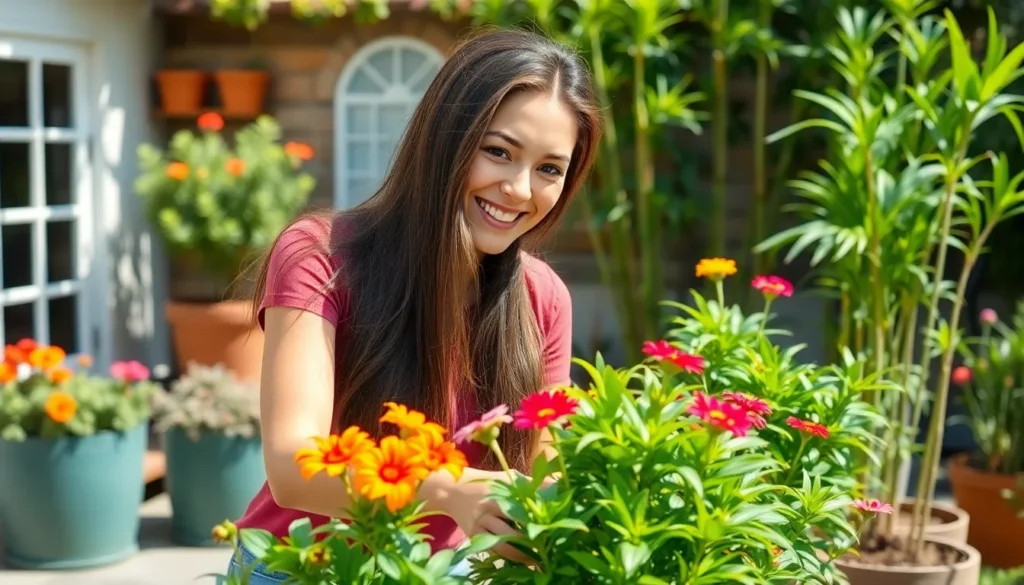Creating a private outdoor sanctuary doesn’t require a massive yard or permanent landscaping changes. Privacy plants in pots offer the perfect solution for anyone looking to shield their space from prying eyes while maintaining complete flexibility and control over their green barriers.
We’ve discovered that container gardening for privacy brings incredible advantages – you can move plants seasonally, experiment with different arrangements, and create instant screening exactly where you need it most. Whether you’re dealing with nosy neighbors, unsightly views, or simply want to carve out a cozy retreat on your patio, the right potted plants can transform your space dramatically.
From fast-growing bamboo varieties to lush evergreen shrubs, we’ll explore the most effective privacy plants that thrive in containers. You’ll learn which species provide year-round coverage, how to choose the right pot sizes, and practical tips for creating beautiful living walls that serve both form and function in your outdoor space.
Choose Fast-Growing Bamboo Varieties for Instant Privacy
We recommend bamboo as one of the most effective answers for creating immediate privacy screens in containers. These remarkable plants can grow several feet in a single season while maintaining their lush green appearance year-round.
Clumping Bamboo Species for Container Growing
Fountain bamboo (Fargesia nitida) thrives in large containers and creates dense privacy screens reaching 8-12 feet tall. This cold-hardy variety tolerates temperatures down to -20°F and produces elegant arching canes with delicate foliage. We’ve found it performs exceptionally well in 25-gallon containers or larger.
Buddha’s belly bamboo (Bambusa ventricosa) offers unique visual appeal with its distinctive swollen internodes and compact growth habit. Growing 6-8 feet in containers, this variety creates excellent privacy while adding architectural interest to your outdoor space. The thick canes provide substantial screening even during winter months.
Hedge bamboo (Bambusa multiplex) forms tight clumps perfect for privacy applications and grows 10-15 feet tall in adequate containers. We recommend this variety for its reliability and dense growth pattern that creates effective visual barriers. Multiple cultivars are available, including ‘Alphonse Karr’ with yellow-striped canes.
Japanese timber bamboo (Phyllostachys bambusoides) produces some of the largest canes among container-suitable varieties. Growing up to 20 feet in optimal conditions, this species creates impressive privacy screens with canes reaching 2-3 inches in diameter. Large containers of 50 gallons or more are essential for this variety.
Non-Invasive Options That Won’t Spread
Clumping growth patterns distinguish safe bamboo varieties from aggressive spreading types that can damage property. These varieties expand slowly from their original root ball rather than sending out underground runners. We always recommend clumping bamboo for residential privacy applications to avoid potential problems with neighbors.
Contained root systems make clumping bamboo ideal for pot cultivation since they won’t break through container walls or spread beyond their designated area. Root barriers become unnecessary when growing these varieties in proper containers. The natural growth habit keeps plants manageable and prevents unwanted expansion.
Fargesia species represent the gold standard for non-invasive bamboo privacy screening in cold climates. These mountain bamboos naturally form tight clumps and never produce spreading rhizomes. We’ve successfully grown Fargesia rufa and Fargesia robusta in containers for years without any spreading concerns.
Bambusa multiplex varieties offer warm-climate gardeners reliable non-invasive options with multiple cultivar choices. These bamboos create dense privacy screens while maintaining predictable growth patterns. Container cultivation further ensures these varieties remain exactly where you plant them.
Select Evergreen Shrubs That Thrive in Containers
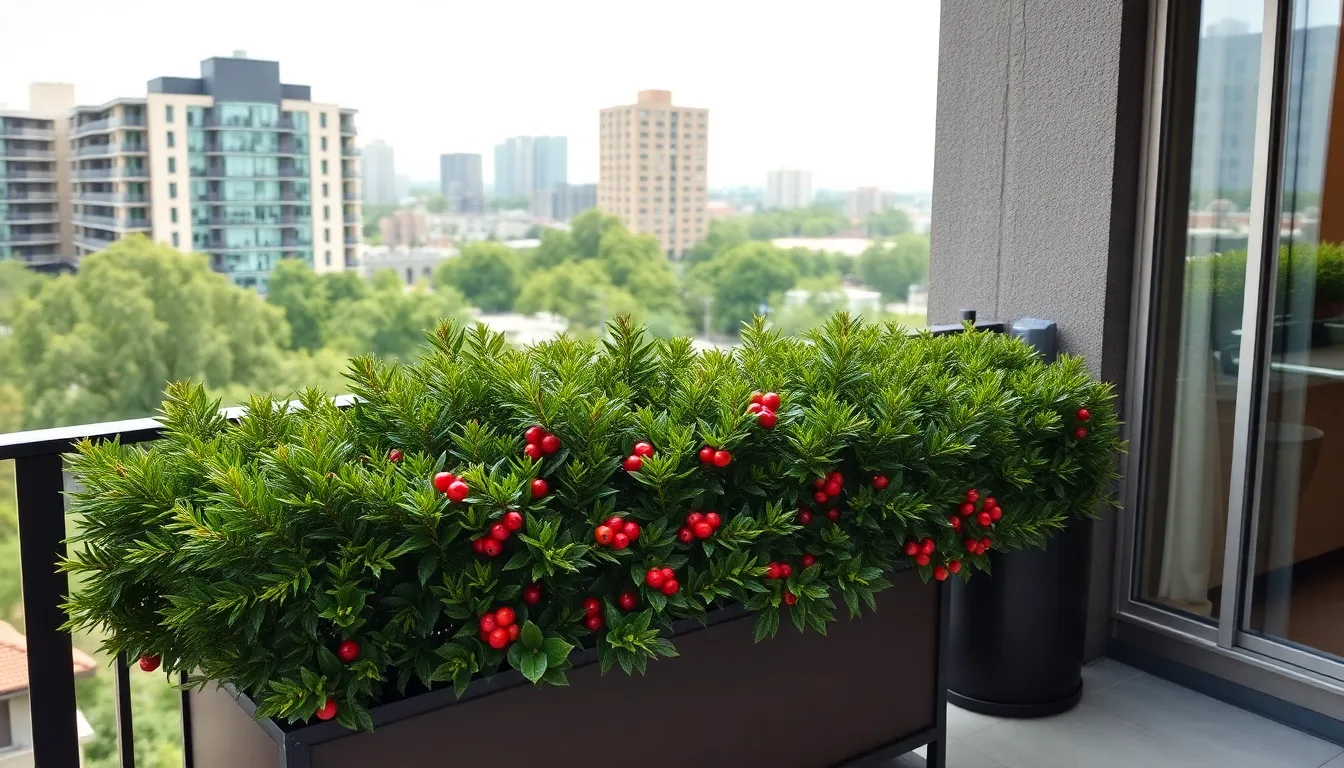
While bamboo offers rapid privacy answers, evergreen shrubs provide the most reliable year-round screening for container gardens. These hardy plants maintain their foliage through all seasons, ensuring consistent privacy coverage when you need it most.
Boxwood and Holly for Year-Round Coverage
Boxwood remains our top choice for formal privacy screening because of its dense, compact growth habit and exceptional tolerance for container life. We’ve found that Buxus species respond beautifully to regular pruning, allowing you to maintain precise shapes and sizes that fit your space perfectly. The classic hedging appearance creates an elegant backdrop for any patio or balcony setting.
Holly varieties deliver both privacy and ornamental appeal with their glossy, dense foliage and often colorful berries that attract beneficial birds to your outdoor sanctuary. Ilex species adapt well to pot culture and can be maintained at manageable heights through consistent pruning practices. Garden serenity increases when these traditional evergreens provide natural habitat while screening unwanted views.
Traditional hedging plants like boxwood and holly bring timeless elegance to container privacy answers, offering formal structure that complements most architectural styles. Both species thrive in well-draining container soil and respond favorably to regular feeding schedules throughout the growing season.
Dwarf Conifer Varieties for Compact Spaces
Dwarf Globe Blue Spruce creates stunning focal points while providing excellent privacy coverage in smaller containers, making it perfect for balconies and compact patios where space comes at a premium. This variety maintains its naturally rounded form without requiring extensive pruning interventions.
Fire Chief™ Thuja offers vibrant seasonal color changes from bright green summer foliage to bronze winter tones, adding visual interest to your privacy screen throughout the year. Slow growing habits ensure this compact variety won’t outgrow its container quickly, reducing maintenance requirements significantly.
Sugar and Spice Thuja provides reliable evergreen coverage with its naturally dense branching pattern that creates effective screening without overwhelming smaller outdoor spaces. Container gardeners appreciate its manageable mature size and consistent growth pattern.
Compact conifer varieties excel in USDA Zones 7 and warmer when planted during spring months, though container cultivation allows for year-round installation with proper care protocols. These slow growing specimens maximize privacy benefits while minimizing space requirements, making them ideal for urban gardening situations where every square foot matters.
Pick Tall Ornamental Grasses for Natural Screening
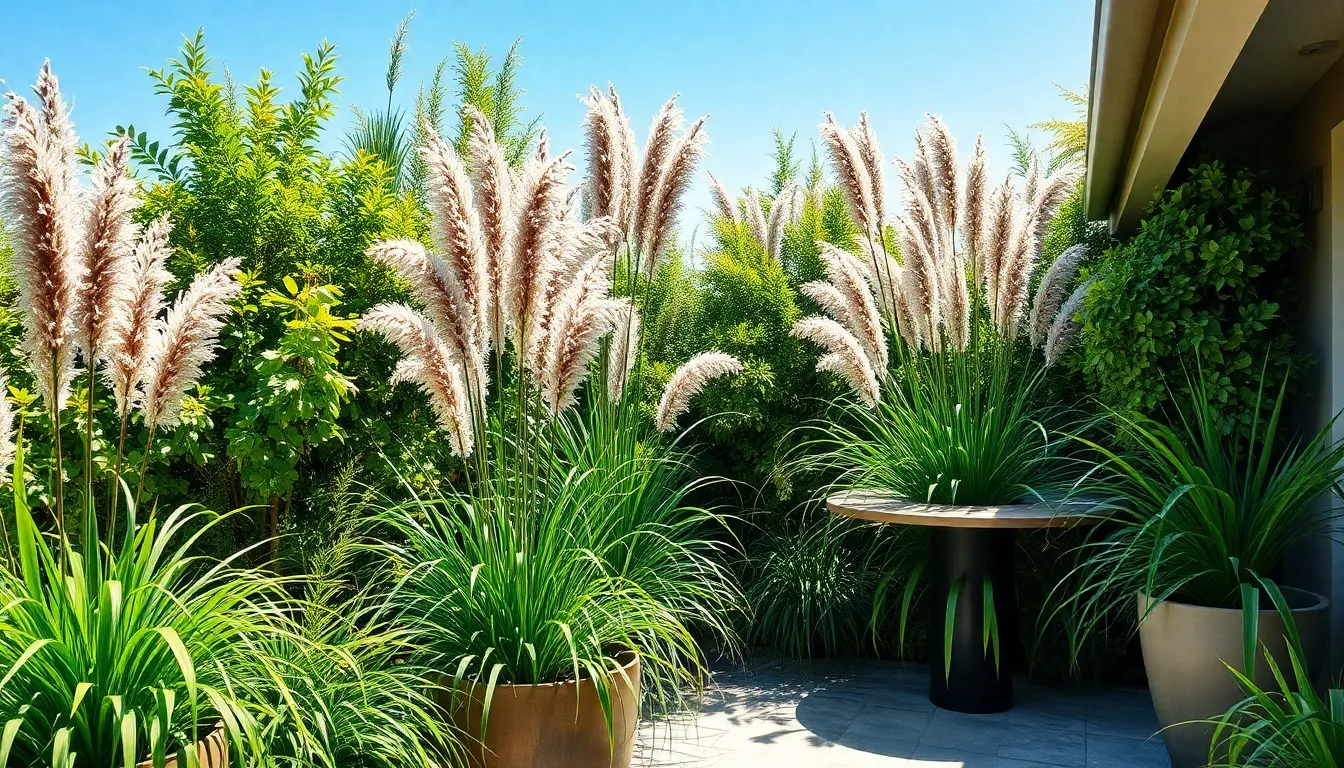
Ornamental grasses offer a softer alternative to bamboo and evergreens while still delivering excellent privacy coverage. We’ve found these grasses particularly effective because they grow quickly and create natural movement that adds visual interest to our outdoor spaces.
Fountain Grass and Pampas Grass Options
Fountain Grass (Pennisetum alopecuroides) creates graceful arching blades that form dense clumps reaching 3-4 feet tall. This grass produces distinctive bottlebrush flower spikes that sway beautifully in the breeze, adding texture and movement to your privacy screen. We recommend choosing large containers at least 20 inches wide to accommodate its spreading growth habit.
Pampas Grass (Cortaderia selloana) delivers dramatic height with its towering plumes that can reach 6-8 feet in containers. The large feathery plumes create an impressive visual barrier while adding architectural interest to patios and balconies. This variety requires substantial containers due to its extensive root system and substantial mature size.
Purple Fountain Grass provides colorful burgundy foliage that transitions to deep purple as temperatures cool. The compact growth habit makes it perfect for layering with taller varieties to create multi-level privacy screens. We’ve successfully combined this variety with other grasses to achieve screens reaching up to 7 feet tall.
Cold-Hardy Grass Varieties for All Climates
Feather Reed Grass (Calamagrostis acutiflora ‘Karl Foerster’) thrives in USDA zones 4-9 and maintains its upright structure throughout winter months. This clumping grass grows vertically rather than spreading, making it ideal for narrow spaces between containers. The variety reaches 4-5 feet tall and produces wheat-colored plumes that persist into winter.
Zebra Grass (Miscanthus sinensis ‘Zebrinus’) handles temperatures down to zone 5 while delivering striking variegated foliage with horizontal yellow stripes. This variety can reach 5-8 feet tall in large containers, creating substantial privacy coverage. The grass produces silvery plumes in fall that add seasonal interest to your screening arrangement.
Switch Grass (Panicum virgatum) tolerates extreme weather conditions from zones 3-9 and requires minimal maintenance once established. Native varieties adapt well to container growing and provide excellent privacy coverage while supporting local wildlife. We’ve observed this grass maintaining its structure even through harsh winter conditions.
Consider Large-Leafed Tropical Plants for Dense Coverage
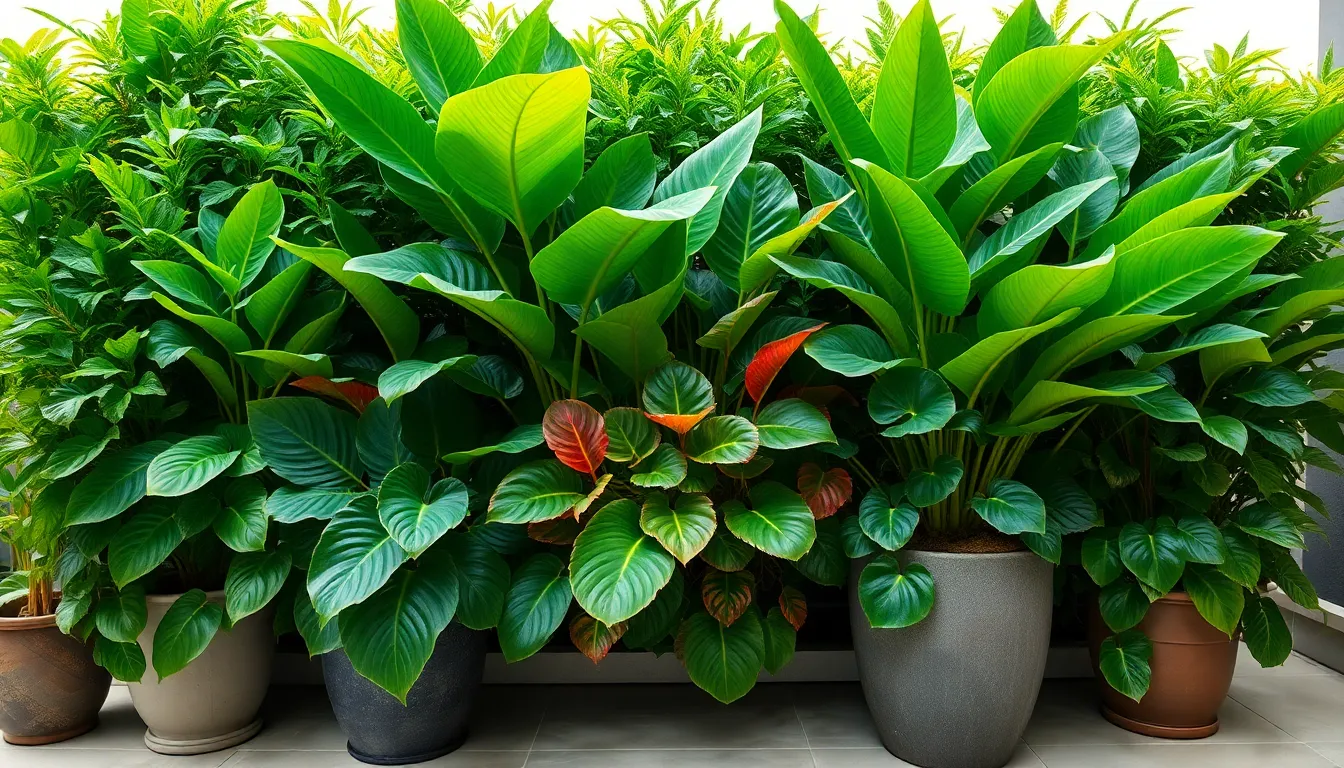
Large-leafed tropical plants create the most effective visual barriers in containers due to their broad foliage that quickly blocks views and diffuses light. We’ll explore dramatic options that transform ordinary patios and balconies into lush, private retreats.
Elephant Ear and Monstera for Dramatic Effect
Elephant Ear plants deliver unmatched privacy coverage with their massive leaves that can grow up to 1 meter long. Alocasia macrorrhizos creates dramatic, dense privacy screens that work exceptionally well in pots for patios or terraces, providing both tropical aesthetics and effective visual screening. Their upright form maximizes coverage while maintaining an elegant appearance in container gardens.
Monstera plants offer sculptural privacy answers through their iconic large, split leaves that create thick and attractive barriers. Monstera deliciosa thrives in indirect sunlight and warm conditions, making it perfect for covered patios and indoor-outdoor spaces. These plants add a striking architectural element while providing substantial privacy coverage in containerized spaces.
Grouping these tropical giants amplifies their privacy potential when placed strategically around seating areas or property boundaries. We recommend combining multiple specimens to create fuller barriers that maximize both visual impact and screening effectiveness. Their bold leaf shapes and sizes transform ordinary container arrangements into dramatic privacy installations.
Cold-Sensitive Options for Seasonal Privacy
Tropical privacy plants require winter protection since they’re sensitive to temperatures below 50°F (10°C). Elephant Ear and Monstera can suffer important damage in frost conditions, making them unsuitable for year-round outdoor use in cooler climates. We suggest treating these plants as seasonal privacy answers that provide maximum impact during warm months.
Moving containers indoors extends their privacy benefits throughout the year in colder regions. These plants adapt well to indoor environments with proper lighting, allowing you to maintain privacy screens on covered porches or sunrooms during winter months. Strategic placement near large windows or glass doors continues their screening function even when brought inside.
Fast-growing alternatives bridge seasonal gaps when tropical plants need winter protection. Brazilian Red Cloaks grow 8-12 feet tall and provide lush, dense color and coverage during warm seasons before requiring indoor relocation. These rapid-growth options ensure continuous privacy coverage while tropical specimens recover or acclimate to indoor conditions.
Proper container sizing supports healthy root systems essential for maintaining the large foliage that creates effective privacy screens. We recommend oversized pots that accommodate extensive root growth and provide stability for top-heavy tropical plants. Adequate fertilization and consistent watering schedules help maintain the dense foliage necessary for optimal privacy coverage.
Choose the Right Container Size and Drainage
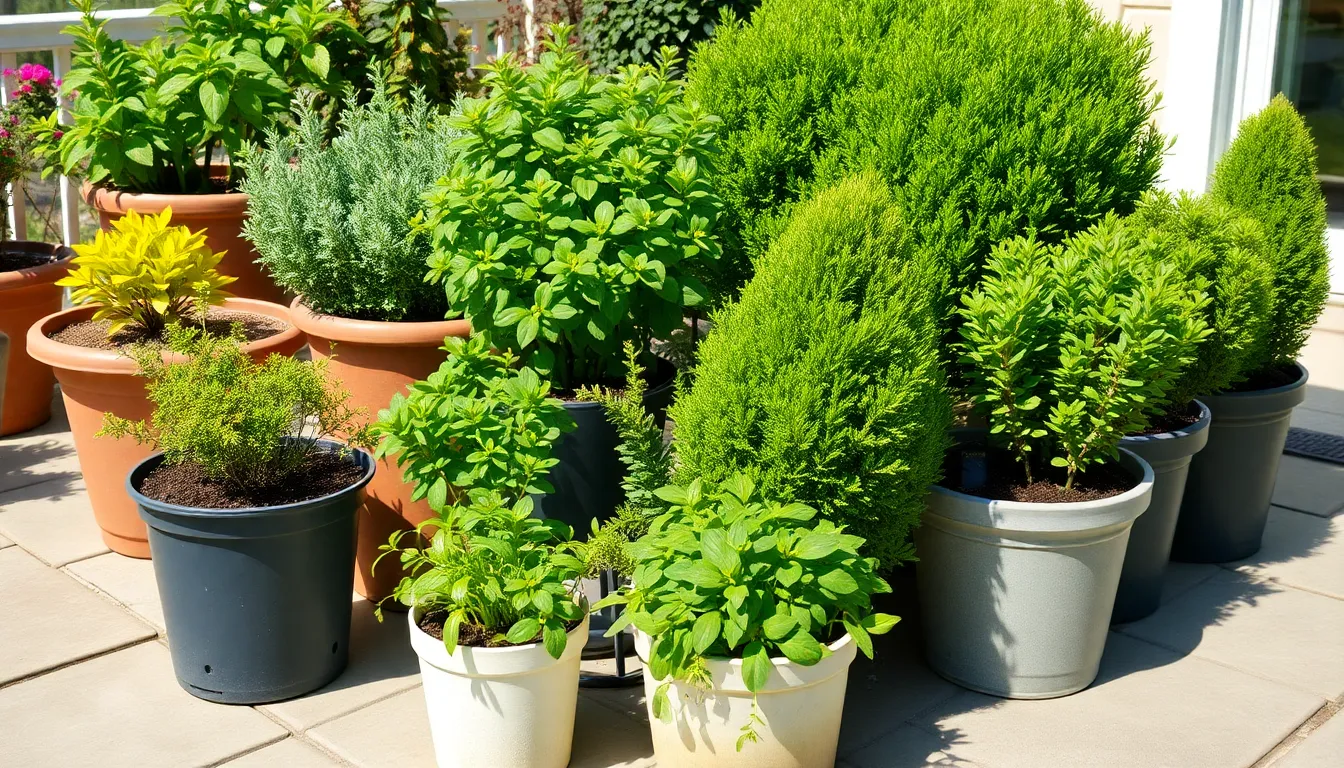
Selecting appropriate container dimensions and ensuring proper drainage form the foundation of successful privacy plant cultivation. We’ll explore the exact requirements that support healthy root development and prevent common container gardening pitfalls.
Minimum Pot Dimensions for Privacy Plants
Small shrubs and herbs require containers measuring at least 12 to 14 inches in diameter, providing 5 to 7 gallons of growing space for their developing root systems. Raspberry bushes and similar small fruiting plants thrive in slightly larger 16-inch containers that hold approximately 10 gallons of soil. Larger shrubs and dwarf trees demand substantial growing space, needing pots with a minimum 24-inch diameter that can accommodate 25 gallons or more of potting medium.
| Plant Type | Minimum Pot Size Diameter | Volume (Gallons) | Notes |
|---|---|---|---|
| Small shrubs, herbs | 12-14 inches | 5-7 | Suitable for smaller privacy plants |
| Small shrubs, fruits | 16 inches | 10 | Supports bushier growth |
| Evergreen shrubs, dwarf trees | 24 inches | 25 | Larger roots need space |
| Hedge planters | 40″L x 14″W x 12″D | N/A | Good for boxwood hedges |
Boxwood hedges perform exceptionally well in rectangular planters measuring 40 inches long, 14 inches wide, and 12 inches deep, allowing roots to spread horizontally while maintaining manageable container dimensions. Tall grasses like pampas grass need deep, wide containers that can support their impressive height and extensive root systems without becoming top heavy. Privacy plants restricted to undersized containers develop weak root systems that can’t support healthy above ground growth, eventually compromising their screening effectiveness.
Essential Drainage Requirements for Healthy Growth
Drainage holes prevent waterlogged soil conditions that suffocate roots and promote harmful bacterial growth in container environments. We recommend drilling additional holes if your chosen containers lack adequate drainage, ensuring excess water can escape freely after watering or rainfall. Well draining soil mixes specifically formulated for container plants provide the optimal balance of moisture retention and drainage that privacy plants require.
Frozen soil in winter containers can create drought conditions even when water is present, making proper drainage and insulation critical for year round plant health. Root rot develops quickly in containers without proper drainage, causing privacy plants to decline rapidly and lose their screening value. Strategic placement of containers allows natural water runoff while preventing standing water around pot bases that can refreeze and damage container materials.
Position Your Privacy Plants Strategically
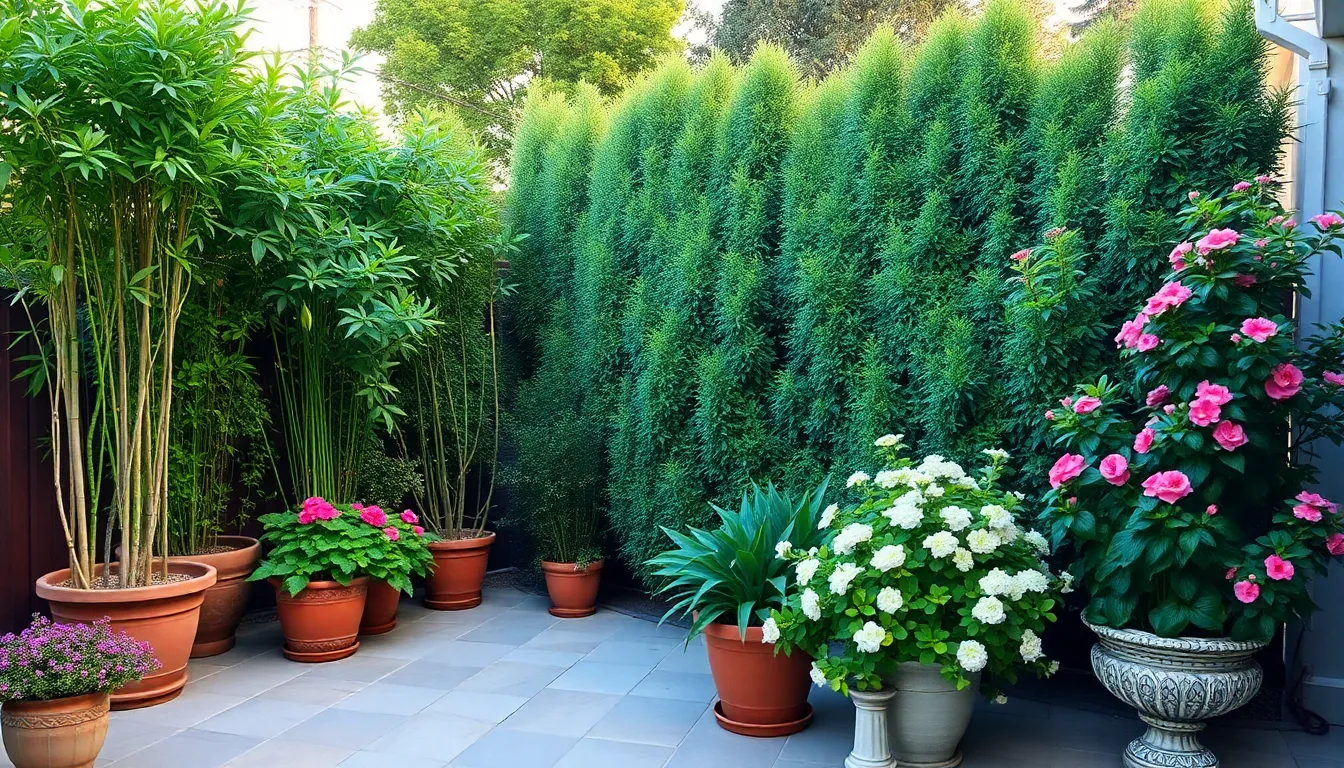
We’ve covered the best plants for container privacy screens, but placement makes all the difference between a scattered arrangement and an effective living barrier. Smart positioning transforms individual potted plants into a cohesive privacy solution that maximizes coverage while maintaining visual appeal.
Group containers to form dense barriers around patios, balconies, or along property lines where privacy matters most. Focus your plants on areas that receive the heaviest foot traffic or where neighbors have direct sight lines into your space.
Layer different plant types to create depth and texture in your privacy screen. Place tall bamboo or ficus trees as your backdrop screening, then position flowering or ornamental plants in front for aesthetic appeal and wildlife attraction.
Angle containers slightly toward the viewing area to maximize the screening effect of each plant’s natural growth pattern. This positioning technique helps fill gaps more effectively than straight linear arrangements.
Optimal Spacing Between Containers
Place containers close enough so plant foliage overlaps when mature, creating that continuous screen effect we’re after. The key is finding the sweet spot between dense coverage and adequate airflow to prevent disease issues.
Space tall plants like bamboo or dwarf spruce about 2 to 3 feet between pots to achieve seamless screening once they reach maturity. This distance allows their natural growth to fill gaps while maintaining plant health.
Cluster smaller shrubs and flowers more tightly together to add fullness and block lower sight lines effectively. These plants can handle closer proximity since they typically have less extensive root systems.
Account for mature plant width when calculating spacing, not just current container size. Research each plant’s expected spread to avoid overcrowding that leads to competition for resources.
Height Considerations for Maximum Coverage
Use tall, fast-growing plants like bamboo, elephant ears, or ficus trees for upper level screening that reaches 6 to 8 feet or more. These create your primary privacy barrier at eye level and above.
Position medium height plants like hydrangeas or ornamental grasses to provide mid level coverage and gentle movement that adds life to your screen. These plants fill the crucial 3 to 5 foot range where most privacy concerns occur.
Add lower plants such as coneflowers or lavender to block lower sight lines without obstructing airflow or natural light. These shorter plants complete your privacy coverage from ground to sky.
Layer heights strategically with tallest plants positioned at the back, medium height plants in the middle, and shorter specimens in front. This arrangement maximizes coverage while creating a natural, tiered appearance that looks intentionally designed rather than randomly placed.
Maintain Your Potted Privacy Screen Year-Round
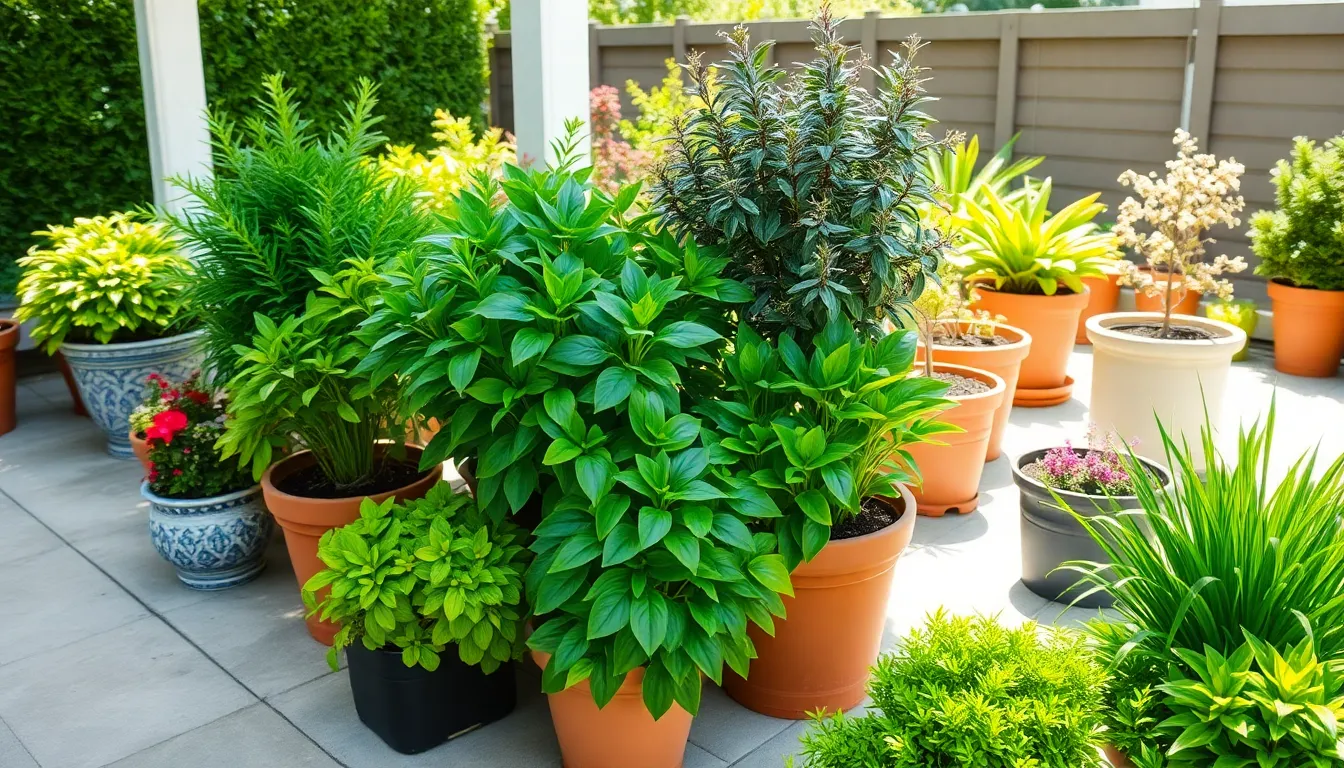
Successful container privacy screens require consistent attention throughout the seasons to maintain their effectiveness and visual appeal. We’ll guide you through the essential seasonal care routines and feeding strategies that keep your living barriers healthy and thriving.
Seasonal Care and Pruning Guidelines
Late winter and early spring represent the ideal time for major pruning activities before the growing season begins. We recommend removing dead or damaged foliage during this period to encourage fresh growth and maintain the plant’s structural integrity.
Throughout the growing season, monitor your privacy plants for pests and diseases while pinching back leggy growth to encourage bushiness. Regular inspection allows us to catch problems early and maintain the dense screening effect we’re seeking.
Fall preparation involves gradually reducing watering frequency as plants enter their dormancy period, though this varies by species. Different plants have varying dormancy requirements, so we adjust our care accordingly.
Winter protection becomes crucial for maintaining container plants during cold months. Insulate pots from freezing temperatures or move non-cold-hardy species indoors to prevent root damage and plant loss.
Fertilizing and Watering Best Practices
Container plants lose nutrients faster than ground-planted specimens due to frequent watering, making regular fertilization critical for healthy growth. We start fertilizing approximately 2-6 weeks after planting, depending on the potting media and plant growth rate.
All-purpose fertilizers containing nitrogen (N), phosphorus (P), potassium (K), and micronutrients provide the foundation for healthy container plants. Select fertilizers with higher phosphorus or potassium relative to nitrogen when promoting flowering or fruiting in blooming privacy plants.
Slow-release granular fertilizers mixed into potting soil feed plants gradually over several months, providing consistent nutrition. We supplement these with water-soluble fertilizers every 2-3 weeks at half strength during the growing season for immediate nutrient availability.
Proper watering technique maintains moist but not soggy soil conditions. Water thoroughly when the top inch of soil feels dry, allowing water to drain through the pot to reach deep roots, and increase frequency to daily watering during hot weather periods.
| Fertilizing Schedule | Frequency | Application Method |
|---|---|---|
| Initial fertilizing | 2-6 weeks after planting | Mixed into potting soil |
| Slow-release granular | Every 3-4 months | Applied to soil surface |
| Water-soluble supplement | Every 2-3 weeks | Half strength during growing season |
| Winter feeding | Reduced or stopped | Varies by plant dormancy |
Combine Different Plant Types for Layered Privacy
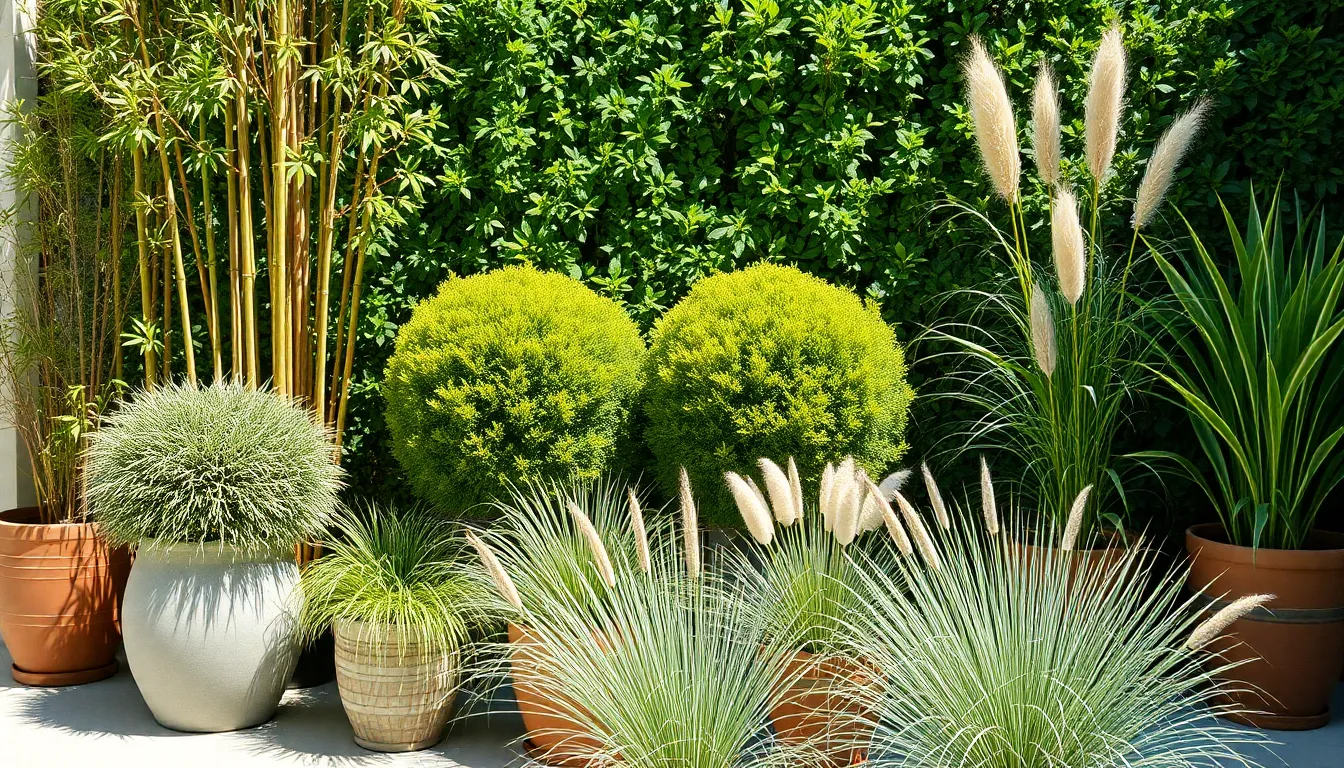
We create the most effective privacy screens by building depth through strategic plant combinations. Our approach focuses on mixing different heights, textures, and growth patterns to achieve natural-looking barriers that outperform single-species plantings.
Mixing Heights and Textures Effectively
Building vertical layers transforms ordinary container arrangements into sophisticated privacy answers. We recommend starting with tall, thin plants such as bamboo or pampas grass as the backbone, then adding rounder shrubs like Privet (Ligustrum spp.) or Heavenly Bamboo (Nandina domestica) to fill middle zones. Container-friendly privacy shrubs provide dense foliage that we can shape for precise height and width control.
Ornamental grasses including Miscanthus and Pennisetum add essential soft texture and movement to our screens. These varieties help our privacy barriers appear more natural and ever-changing in containers while creating gentle sound barriers. We position these grasses between structural shrubs to soften harsh lines.
Textural diversity from fine grassy leaves to broad, glossy shrub leaves increases privacy effectiveness significantly. Large-leaf annuals like Canna Lilies or Elephant Ears serve as bold foreground layers with their vigorous growth patterns. We use these broad-leaved plants to fill gaps and create lush, layered appearances that maximize screening potential.
Creating Natural-Looking Arrangements
Grouping plants in containers rather than placing single pots apart creates authentic privacy screens. We layer taller pots behind shorter ones to mimic natural plant communities found in established gardens. This clustering technique helps us achieve better coverage while using fewer individual plants.
Color coordination and complementary growth habits prevent our privacy screens from appearing forced or artificial. We select plants that naturally complement each other in form and foliage to create seamless transitions between different species. Our combinations focus on plants with similar water and light requirements for easier maintenance.
Flowering shrubs and scented plants like lavender enhance our privacy arrangements beyond basic screening. These additions draw beneficial pollinators while adding sensory appeal to our outdoor spaces. We strategically place these accent plants where their fragrance and blooms can be appreciated without compromising the primary privacy function.
Budget-Friendly Options for Large-Scale Privacy
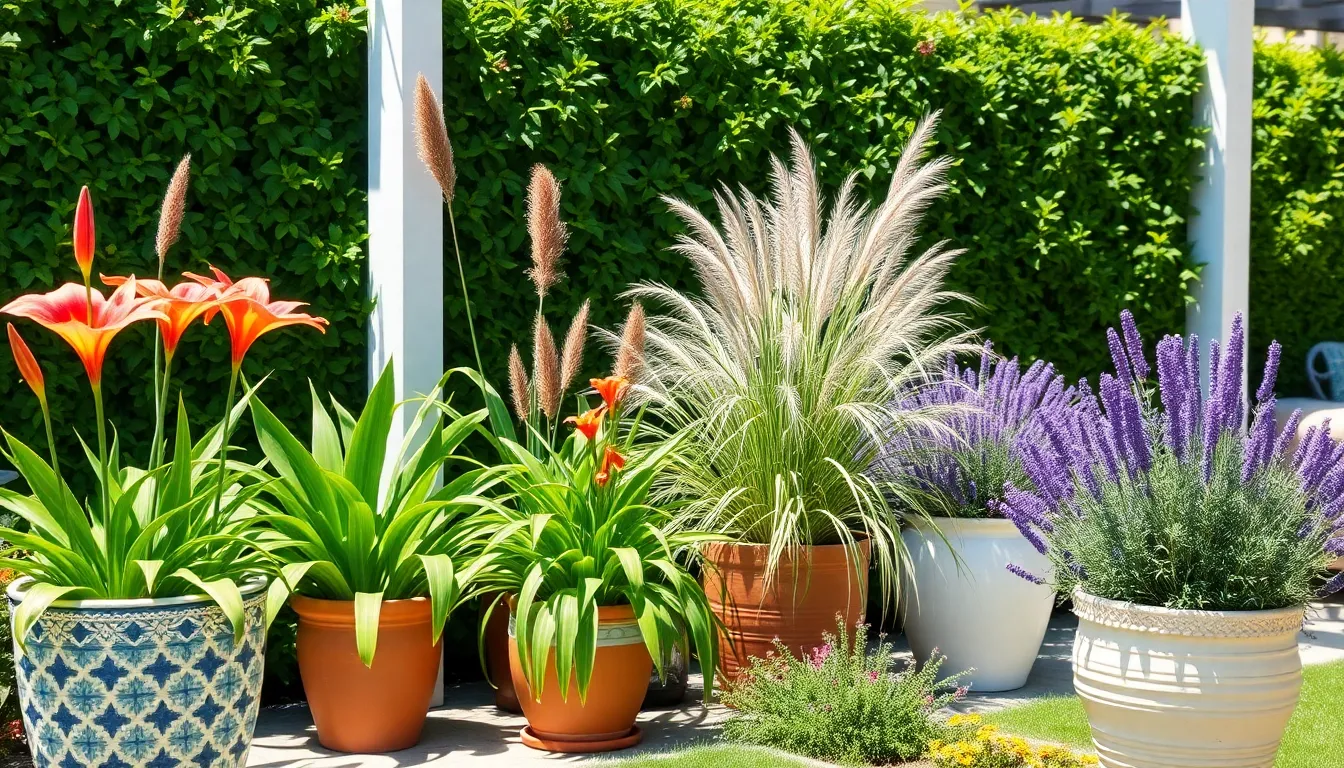
Creating extensive privacy screens doesn’t have to drain your wallet when you choose the right plants and containers strategically.
Cost-Effective Plant Choices
Fast growing annuals offer the most immediate bang for your buck when creating large scale privacy. Canna Lilies and Elephant Ears grow thick and fast, providing instant coverage without needing companion plants for blocking views. These vigorous growers establish dense screening quickly, making them perfect for rental properties or temporary privacy needs.
Pampas Grass reaches impressive heights up to 10 feet, delivering dramatic privacy coverage in appropriately sized containers. We recommend using large pots to accommodate its substantial root system and keeping it away from high traffic zones due to sharp leaf edges. Full sun exposure and winter protection in cooler zones ensure optimal growth performance.
Privet shrubs combine fast growth with exceptional pruning tolerance, making them ideal budget friendly container privacy screens. Regular watering and well draining soil keep these upright growers thriving, while larger pots prevent root confinement issues that can stunt development.
Heavenly Bamboo provides tough broadleaf evergreen coverage with bamboo like foliage and colorful fruit displays. This adaptable plant reaches about 8 feet tall with minimal upkeep requirements, adding year round visual interest while maintaining cost effectiveness.
Lavender varieties contribute fragrant foliage and flowers while offering excellent drought tolerance up to 3 feet in height. Provence hybrids deliver repeat blooming when pruned properly, adding both privacy and pleasant scents to container gardens.
Ornamental grasses generate pleasant rustling sounds while effectively blocking street noise and softly screening views. Their movement and drought resistance make them popular container choices without the bulky appearance of traditional shrubs.
DIY Container Answers
Large scale planters from various suppliers offer multiple sizes and colors to match your space and style requirements perfectly. These containers provide adequate room for root growth and stability for tall privacy plants while maintaining reasonable costs.
Layered planting combinations using fast growing tall plants with medium sized shrubs create flexible privacy density. This approach allows container manageability while achieving effective screening through strategic plant placement and height variation.
Lightweight durable materials for containers ease relocation needs and minimize initial investment while ensuring proper drainage capabilities. Choose materials that balance cost effectiveness with weather resistance for long term container garden success.
Regular pruning schedules promote dense growth patterns and extend the privacy effectiveness of container plants significantly. Maintenance routines keep plants healthy and maximize their screening potential throughout growing seasons.
Conclusion
Creating your perfect privacy oasis with potted plants isn’t just achievable—it’s one of the most rewarding ways to transform any outdoor space. We’ve shown you that whether you’re working with a tiny balcony or spacious patio you can design a living screen that evolves with your needs.
The flexibility of container gardening means you’re never locked into permanent decisions. You can experiment with different arrangements seasonal changes and new plant varieties as your privacy requirements shift over time.
With the right combination of fast-growing bamboo evergreen shrubs ornamental grasses and budget-friendly options you’ll have a thriving privacy screen that enhances both your outdoor sanctuary and property value. Start small choose plants suited to your climate and watch your container privacy garden flourish into the peaceful retreat you’ve always wanted.
Frequently Asked Questions
What are the best plants for creating privacy in containers?
The top container privacy plants include clumping bamboo varieties (Fountain, Buddha’s belly, and Hedge bamboo), evergreen shrubs like boxwood and holly, dwarf conifers such as Dwarf Globe Blue Spruce, and tall ornamental grasses like Pampas and Feather Reed Grass. These plants provide excellent screening while thriving in containers.
How quickly can bamboo create a privacy screen?
Bamboo is one of the fastest-growing privacy solutions, with certain varieties capable of growing several feet in a single season. Clumping bamboo species like Fargesia and Bambusa multiplex varieties provide immediate privacy screening while remaining non-invasive and manageable in containers.
What’s the difference between clumping and running bamboo?
Clumping bamboo grows in tight clusters and expands slowly, making it ideal for containers and residential privacy without spreading uncontrollably. Running bamboo spreads aggressively through underground rhizomes and can become invasive. For privacy screens, clumping varieties are always recommended.
Can evergreen shrubs survive in containers year-round?
Yes, evergreen shrubs like boxwood, holly, and dwarf conifers thrive in containers and provide reliable year-round privacy screening. These plants are specifically selected for their adaptability to container life and ability to maintain their foliage through all seasons.
What are budget-friendly options for container privacy screens?
Cost-effective privacy plants include fast-growing annuals like Canna Lilies and Elephant Ears, Pampas Grass for dramatic height, fast-growing Privet shrubs, and drought-tolerant Lavender varieties. These options provide excellent coverage without significant financial investment while offering quick results.
How do I choose the right container size for privacy plants?
Large-scale planters are essential for privacy plants to accommodate root growth and provide stability for tall specimens. The container should be proportional to the plant’s mature size, with adequate drainage and enough soil volume to support healthy growth and prevent toppling.
What ornamental grasses work best for natural privacy screening?
Fountain Grass offers graceful arching blades, while Pampas Grass provides dramatic height and impressive plumes. Cold-hardy options like Feather Reed Grass, Zebra Grass, and Switch Grass adapt to various climates and provide substantial privacy coverage while supporting local wildlife.
Can I create layered privacy screens with different plants?
Yes, layered planting combinations allow for flexible privacy density and visual interest. You can combine tall bamboo or grasses in back, medium-height shrubs in the middle, and shorter plants in front to create a natural, tiered privacy screen that maximizes coverage.
Do container privacy plants require special maintenance?
Container privacy plants need regular watering, appropriate fertilization, and periodic pruning to maintain shape and promote dense growth. Regular pruning is especially important for achieving optimal privacy coverage and keeping plants healthy and manageable in their containers.
What are the advantages of using containers for privacy screening?
Container privacy screening offers flexibility to move plants, experiment with arrangements, and create instant screening without permanent landscaping changes. This approach is perfect for renters, small spaces, or anyone wanting to modify their privacy setup seasonally or as needs change.

